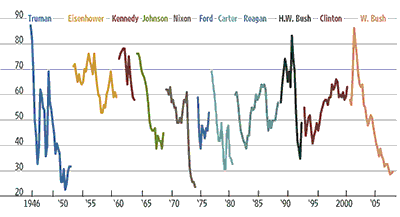 There are several charting principles. But the most effective of them all is “KISS”.
There are several charting principles. But the most effective of them all is “KISS”.
By kiss, I don’t suggest that you kiss the chart designer (although it might work). By kiss, I mean “Keep It Simple, Stupid”
Today I want to feature a very simple and effective chart from Wall Street Journal. It tells you the story of 11 US presidents, all the way from Truman to Bush and how their approval ratings were during the presidency.
OK, ok, show me the chart

Approval ratings of Past U.S. Presidents : From Truman to Bush
Well, so what is great about this chart?
First look at the amount of data, 11 US presidents, approval ratings from almost 60 years, someone else might have gone nuts and created huge amount of overlapping balls or animated dots or something else. But not the wise folks at WSJ. They chose to present the data in a simple yet very effective line chart. They have colored each president uniquely and added exact amount of grid lines and labels.
Aha, how can this help me?
Simple, “keep your charts simple”. No matter how complex your data is or how lengthy your formulas are, when it comes to presenting the results, simple charts and visualizations always outdo the more complicated and elaborated charts.
Hmm, Fair enough, why don’t you tell me some guidelines then?
- Prefer bar, column, line and XY scatter charts
- Keep your chart design minimalistic. Avoid un-necessary labels, grid lines and axis stuff
- Pick-up colors that go along with each other. Simple rule: either pick shades of same color or totally different colors that contrast.
- If you plan to highlight something, make it really stand out. I mean REALLY.
None of these rules are rocket science. They are common sense. But it is very easy to loose common sense in the plethora of functionality offered by the chart designing software (excel or something else).
Happy weekend, and yeah if you are still kissing your chart designer, may be its time you subscribed to our RSS Feed or E-Mail updates.


















15 Responses to “Christmas Gift List – Set your budget and track gifts using Excel”
[...] Christmas Gift List – Set your budget and track gifts using Excel … [...]
I'm confused: if you spend $10, and your budget is $40, shouldn't the amount in the "Within Budget?" column stay black, since you didn't go over budget?
In other words, since we overspent on the electronic photo frame, shouldn't the $8 cell turn red?
@JP.. maybe Steven is encouraging consumerism... ?
I havent realized it earlier, but now I see it. If you unprotect the sheet, you can change the formula in Column I to =IF(G13=0;" ";F13-G13) from =IF(G13=0;" ";G13-F13), that should correct the behavior.
Thanks Chandoo. I thought of making a shopping list spreadsheet for Christmas, but this is neat so I think I'll use this instead.
Chandoo & Steven thanks for this spreadsheet. But for the sake of a person who has been staring at this megaformula in vain for the last 40 mins and not afraid to ask, would it be possible for you to walk us through the logic used here?
=SUM(SUMPRODUCT(SUBTOTAL(3,OFFSET($K$13:$K$62,ROW($K$13:$K$62)-MIN(ROW($K$13:$K$62)),0,1)),--($K$13:$K$62="-"))+SUMPRODUCT(SUBTOTAL(3,OFFSET($K$13:$K$62,ROW($K$13:$K$62)-MIN(ROW($K$13:$K$62)),0,1)),--($K$13:$K$62="0")))&" / "&SUBTOTAL(2,$G$13:$G$62)
Thanks Chandoo.. This is one of the best budget spreadsheets I've ever seen.. The Arrays are out of this world!! And it's FREE!!
Chandoo, can you tell us more about Steven? Does he have his own site?
JP, I think Chandoo changed it when he changed the currency formatting from £ to $, a negative figure is a good thing in this case. But don't change the formulas, the overbudget and under budget won't work properly if you do. Also Chandoo I think you've accidentally broke the conditional formatting for the alternating row colouring the formula is different to the version I sent you. As for the megaformula chrisham, it gave me a headache trying to get it all working, so I will let Chandoo talk you through it.
Hi,
In cells I6 and I7, I understand that subtotal together with offset function returns an array of ones after which, the sumproduct function gives the desired result.
But I’m not able to figure out the reason for using an array in I8 to return the most expensive gift.
Can’t the formula be just
“=VLOOKUP(SUBTOTAL(4,$G$13:$G$62),$G$13:$J$62,4,0)”
Savithri, Cell I8 needs the array, if the formula was “=VLOOKUP(SUBTOTAL(4,$G$13:$G$62),$G$13:$J$62,4,0)” it would find the highest price from the filtered range (i.e. highest actual in filtered range is $50) BUT then return the first person with that actual, not looking in just the filtered range (so first person on the list with a $50 actual.)
To see what I mean, change the formula, then change all the actuals to $50 then filter for baby, it lists the first name on the list.
But a good question 🙂
Thank you. I now realise that the array is used to get the ‘filtered range’ instead of the entire range, as table array for look up value.
[...] Download This Template [...]
this looks like an awesome excel sheet!! is there anyway i can get it emailed to me unprotected? for some reason, i am unable to download it 🙁 help!!
Hi I also can not download to a mac as the sheet is protected any help would be great
[...] to send her a pricey present. Rather, send a card with a picture of your child. Here’s a cool Excel sheet that will help you estimate your budget per person and let you track [...]
[...] husband and I pour/poor over the Christmas spreadsheet (yes, I do know how dorky that sounds, but we’re not the only ones!), figuring out who should give what to whom. We live at a distance from most of our family, so it [...]